|
Color, Form and Function in Imperial Ceramics
For more than eight thousand years Chinese potters have made ceramic vessels both for daily use and for ceremonial purposes. Most of the ceramics created, whether for emperors or commoners, were utilitarian. Similarly, most of the wares created at the imperial kilns at Jingdezhen for the Ming- and Qing-dynasty emperors were put to use. The form and color of an imperial ceramic piece are often indicative of the function that it served. Imperial meals included a wide range of delicacies served in a dazzling array of bowls and plates, each distinct in form and decoration. One can only imagine the number of porcelain vessels used for special Qing-dynasty imperial sixtieth birthday banquets that imperial documents describe as including more than one thousand guests in attendance. During the Qing dynasty, one’s rank determined the colors and patterns that one could use at table. The imperial factories also created a wide range of forms to decorate the many rooms and gardens of the imperial palaces. During the Ming and Qing dynasties, altar vessels such as stem cups and censers, which had their origins in bronze forms, were often made of porcelain. Monochrome wares were specially produced for the four altars used for imperial ceremony and sacrifice. For example, brilliant yellow ceramics were used at the Altar of Earth, and deep blue ceramics were used at the Altar of Heaven.
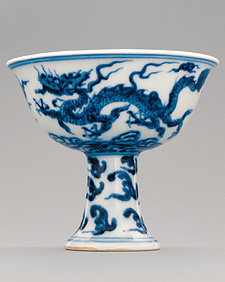 | Stem cup
China, Jiangxi Province;
Ming period (1368–1644), Xuande era, 1426–1435
Porcelain painted with underglaze cobalt blue (Jingdezhen ware)
During the Ming dynasty, imperial regulations permitted nobility of lower rank to use objects decorated with four-clawed dragons, such as the powerful creature on this small cup. A six-character Xuande reign mark is written in the bottom of the interior. |
Stem cup
China, Jiangxi Province
Ming Period, 1368–1644, mid to late 15 th c. (probably Chenghua era, 1465–1487)
Porcelain painted with underglaze cobalt blue and overglaze red enamel (jingdezhen ware)
The two stem cups on view here reflect a basic form that the Chinese have used for ritual vessels for thousands of years. Stem cups, along with other ritual vessels, were created for placement on ritual altars. Scholars have suggested that the winged creatures flying over the waves on this stem cup may refer to China’s position as the world’s most important seafaring empire in the fifteenth century. | 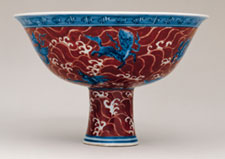 |
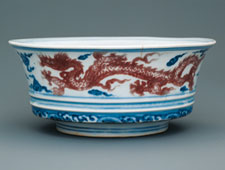 | Bowl
China, Jiangxi Province;
Ming period (1368–1644), Xuande era, 1426–1435
Porcelain painted with underglaze cobalt blue and copper red (Jingdezhen ware)
This luxurious bowl, which originally had a cover, may have been part of a larger set of imperial dishes for dining. In the fifteenth century the motif of a dragon chasing a pearl became a prominent imperial symbol in the arts and the five-clawed dragons give further indication that this bowl was intended for the use of the Xuande emperor. A six-character Xuande reign mark is on the interior.
|
Covered jar
China, Jiangxi Province; Ming period (1368–1644), Jiajing era, 1522–1566
Porcelain painted with underglaze cobalt blue and overglaze enamels
(Jingdezhen ware with wucai or "five-color" decoration )
The bold treatment and lively movement of the fish and aquatic plants painted on this covered jar typify a new aesthetic in early 16th-century ceramics inscribed with imperial reign marks. Jars of this type are more heavily potted than other pieces that bear imperial marks, probably because of their relatively large size and because they are generally believed to have been used as outdoor decoration in gardens. A Jiajing reign mark appears on this jar.
|
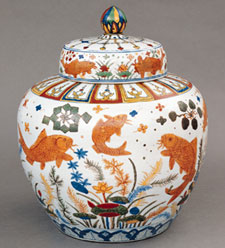 |
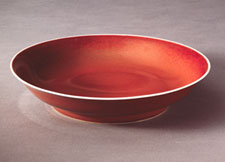 |
Dish
China, Jiangxi Province; Ming period (1368–1644), mid- to late 15th century (probably Chenghua era, 1465–1487)
Porcelain with copper-red glaze (Jingdezhen ware)
Red was the banner color for the Ming family, possibly chosen because the imperial Ming family surname, Zhu, can be translated as "red." The red color of the glaze, known as "sacrificial red" (jihong), was first developed and perfected during the reign of the Xuande emperor (reigned 1426–1435). The name suggests that “sacrificial red” glazed porcelains were used as ceremonial wares during the Xuande era.
|
Dish
China, Jiangxi Province; Ming period (1368–1644), Hongzhi era, 1488–1505
Porcelain with overglaze yellow enamel (Jingdezhen ware)
The rounded forms and brilliant yellow glazes of this dish and the slightly later one next to it rely on prototypes established in the early 15th century. Yellow pieces like these two dishes are known to have been used to decorate the Altar of Earth (Diqitan), one of the four main altars used in imperial ceremonies and sacrifices.
| 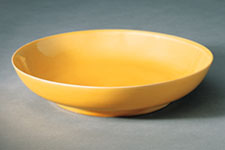 |
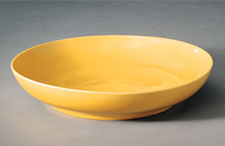 | Dish
China, Jiangxi Province; Ming period (1368–1644), Zhengde era, 1506–1521
Porcelain with overglaze yellow enamel (Jiangdezhen ware)
|
|